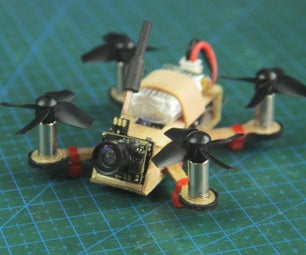Introduction: DIY Variable Power Supply With Adjustable Voltage and Current
Hey Guyz, This time I'm making a variable bench power supply.This is the most useful equipment for a hobbyist and DIY maker cause while making or testing circuits, it needs different values of voltage and current. That's why every DIY maker must have their own bench power supply. Now I'm going to show you how to build an awesome variable bench power supply. So take your tools and let's get started :)
If you like this project then please do vote for me :)
I'm using here LTC3780 DC adjustable buck and boost converter. which is an amazing module. It can deliver DC (1-30V) and up to 10A current depends on your input power source, in my case I'm using DC 12V 3A input power source. I easily get continuously adjustable output voltage (1-30V) and current (0-6A), which is pretty enough for circuit testing and other things.I'm also using 7805 voltage regulator IC for 5V constant voltage and current.
This Power Supply Has Following Features:
- Input Voltage 12V DC.
- Input Current 3A.
- Output Voltage (1-30V) Continuously Adjustable.
- Output Current (300mA-6A) Continuously Adjustable.
- Output ripple 50mV.
- Constant Voltage And Constant Current.
- Aditional 5V Constant Output.
- Short Circuit Projection.
Here's The Complete Tutorial And Demonstration Video.
Step 1: The Parts List
We need these following parts to build the power supply. I bought some from online and some from the local store.
Parts List:
- LTC3780 DC Adjustable Converter
- Digital Voltmeter Ammeter Display
- 500k & 200k Linear Potentiometer
- 12V DC Fan
- 7805 IC For 5V
- 12V 3A Adapter
- 100uF & 10uF Capacitor
- 1N4001/1N4007 Rectifier Diode
- Banana Socket 4ps
- Knob 2ps
- DC Switch
- 2.1mm DC Jack Connect
- Wires
- HeatSink
- Wooden Blocks
- PCB Board
- 4mm Acrylic Sheet
Tools List:
- Glue Gun
- SuperGlue
- Sandpaper
- Mini Handsaw
- Soldering Iron
- Masking Tape
- Drill Machine
- Rotary Tool
- Spray paint
Step 2: Cutting the Acrylic Sheet
I'm using here acrylic sheet to making the enclosure of my power supply. This is an amazing material cause it is easy to cut, bend and sand. it's also so affordable. You can use the acrylic sheet to make your own power supply. So let's get started.
- First, take a measurement of acrylic sheet.
- Cut the acrylic sheets according to the marking.
- Place the voltmeter display and mark it.
- Next cut the marked section with a rotary tool and metal file.
- Again mark the areas for air passing
- Cut the marked area using a mini hacksaw.
- Take the measurements of dc socket, dc switch and dc fan, then mark it.
- Drill the holes and smooth the edges with a metal file.
Step 3: Sanding the Pieces
First, remove the paper cover of the acrylic sheets. Then sand the acrylic sheets until getting a smooth flat surface.
Step 4: Attaching the Pieces
We'll start off by applying super glue on the edges of upper and lower panels. Next, attach the side panels to each panel.
Step 5: Painting the Pieces
I decided to paint the upper and lower encloser of my power supply. I choose matt black colour for my power supply.
Step 6: Attach Extra Pieces
We need some extra pieces for mounting screw. Now take four same size pieces and attach these pieces using super glue.
Step 7: Attaching Front and Back Panel
First, apply a great amount of superglue on the edges of the front panel. next, quickly position it to the lower encloser, then hold it for a couple of minutes. Use this same method to attach the back panel.
Step 8: Mounting Components
In this Step, we'll mount every component. First, we'll start off by mounting dc switch. Then we'll use the screw to mount the dc fan. Then we'll mount other components respectively.
Step 9: Mounting the Heat Sink
It's necessary to reduce the temperature of the power supply. So we need a heatsink and a cooling fan. Though LTC3780 dc converter has an inbuilt heatsink and this converter doesn't heat up. You can skip the additional heatsink. I'm here additional heatsink for better efficiency.
- First drill holes on the wooden block
- Use the screw to attach the heatsink to the wooden block.
- Now apply hot glue on the wooden block.
- Attach the wooden block to the enclosure.
Step 10: Removing the Inbuilt Potentiometer
In this step, we're going to replace the inbuilt potentiometer of LTC3780 with the linear potentiometer.
- First, remove the inbuilt 500k and 200k trimmer potentiometer using soldering iron.
- Now solder wires to solder joint of the trimmer potentiometer.
- Solder those wires to new 500k and 200k linear potentiometer.
Note: When removing the trimmer potentiometer make sure that you don't heat the board too much. it could damage the dc converter.
Step 11: Making the 5V Converter
I'm using here 7805 IC for addition 5v constant output. First, solder the components then Add a heat sink to reduce the heat.
Step 12: Wiring Diagram
This is the complete circuit diagram of this power supply. You've to connect every component according to this circuit diagram.
Step 13: Final Wiring
In this step, we'll solder every component according to the circuit diagram. After soldering every component, i tied all the wires with zip ties.
Step 14: Final Asembly
Now Attach the upper enclosure with screws. Finally, we're done now. Plug the dc jack and the power supply ready provide (0-30)V and Up to 6A Output Current.
Thanks for watching this instructable. If you like this project then please do vote for me. I really need your vote and I know that you will do it.

Runner Up in the
Box Contest 2017

Participated in the
Plastics Contest













